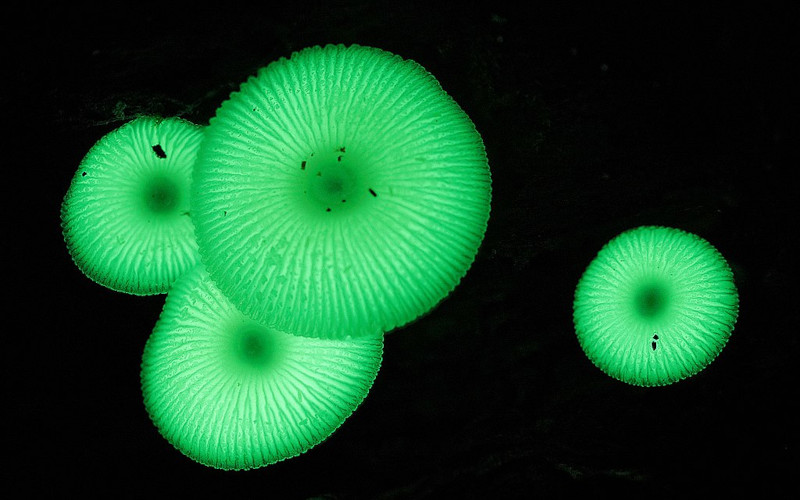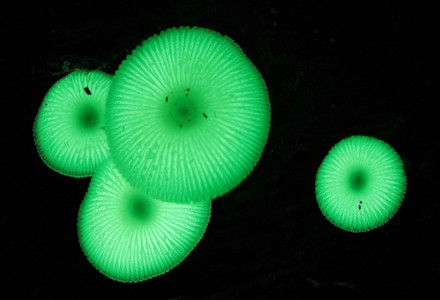
Mycena Chlorophos Facts
- This truly extraordinary variety of fungus remains known to researchers by its relatively unassuming scientific name of the Mycena Chlorophos. For the moment, the remarkable species has no generally accepted common name.
- Only the name of the awesome fungus fails to impress those who encounter it or learn of it, however. This fascinating fungus actually represents one of the handful of known related species that actually displays a natural luminescence.
- The first recorded scientific description of the Mycena Chlorophos occurred in the year 1860. This occurred as a result of the combined efforts of the English researcher Miles Berkeley, and the American botanist, Moses Ashley Curtis.
- Quite unfortunately, scientists still do not know a significant amount about this incredible work of Nature. This regrettable lack of knowledge occurs due to a combination of it short duration and highly limited territorial range.
- Currently, the IUCN has no listing for it on its Red List of Threatened Species. The marvel does, however, face several serious threats to its existence. Although habitat loss remains a danger, its greatest peril most likely stems from climate change.
Related Articles
Icicle Mushroom Phallus Indusiatus Amethyst Deceiver
Mycena Chlorophos Physical Description
Regardless of its other claim to fame, the Mycena Chlorophos represents a comparatively small variety of mushroom. Thankfully, though, Nature often demonstrates that physical size has absolutely no bearing on the impressiveness of its many distinctive creations.
The height of its comparatively thin stalk actually varies quite significantly, measuring from 0.2 – 1.2 in (6 – 30 mm). Its cap, meanwhile, also ranges in size over a broad range. But, this portion of it typically does not exceed roughly 1.2 in (30 mm) in total diameter.
The same cap also possesses a thin coating of a harmless, though surprisingly sticky, substance. The most notable feature of the Mycena Chlorophos, however, obviously remains its naturally occurring luminescence. This presents as a pale green.
It also holds one more fascinating, if somewhat unpleasant, characteristic. This unique wonder of evolution emits a comparatively strong odor of ammonia. Due to the presence of this particular scent, the relative edibility of this fungi remains in question
- Kingdom: Fungi
- Phylum: Basidiomycota
- Class: Agaricomycetes
- Order: Agaricales
- Family: Mycenaceae
- Genus: Mycena
- Species: M. chlorophos
Mycena Chlorophos Distribution, Habitat, and Ecology
The Mycena Chlorophos grows endemically only in a very limited area of the world. This consists of certain portions of subtropical Asia. More precisely, these sections include the countries of Taiwan, Polynesia, Japan, Sri Lanka, and the island of Java, in Indonesia.
To the amazement of some, this mushroom also grows in completely different parts of the globe. In fact, these alternate zones include small portions of Brazil and Australia. However, experts believe that humans accidentally transported it to those locations.
Most fortunately for it, the Mycena Chlorophos has another trait working in its favor. Within these widely different ranges, the species appears to have evolved as highly adaptable. As a result of this evolutionary advantage, it may be found in a variety of forest habitats.
Wherever it appears, though, it nonetheless displays a decided preference for a specific environment. That’s due to the fact that it appears almost exclusively among areas of woody debris. This most commonly includes pieces of fallen bark, branches, and twigs.
The trademark bioluminescence for which it remains best known, however, doesn’t last very long. In point of fact, it’s most pronounced when the mushroom first develops. Afterward, the eerie glow slowly fades over a period that typically measures roughly 72 hours.
Species Sharing Its Range
Javan Rusa Jabuticaba Mandarin Duck
Check out our other articles on 5 Completely Unique Volcanoes, Indian Pipes, Spinner Shark, Pearl Shoal Waterfall, Rainbow Grasshopper, Spiny Bush Viper

